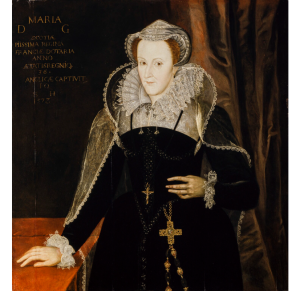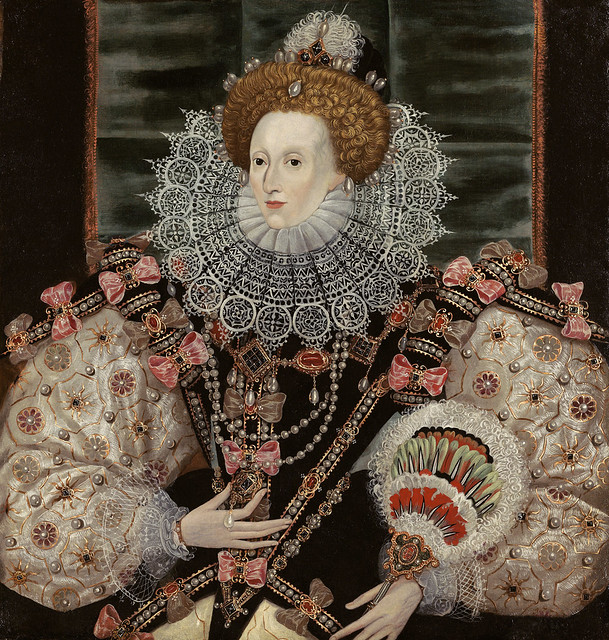
While Queen Elizabeth is often known for being the monarch who presided over the defeat of the Spanish Armada, who defended the Protestant faith, and who was the headstrong virgin queen who refused to marry, perhaps her most controversial encounter was with her own cousin Mary Stuart, Queen of Scots. In Mary Stuart, Elizabeth faced a relentless threat to her crown as well as to her life. Elizabeth and Mary stood on opposite sides of the greatest conflicts of their time: they embodied the growing conflict between Protestants and Catholics, between Tudors and Stuarts, and between that most ancient of rivalries, the English and the Scottish. These two monarchs’ conflicts lasted from 1561 to 1587 and ended in one final and fatal decision. Yet, despite nearly three decades of obsession with one another, the two women would never actually meet. Their explosive relationship played out entirely through letters written with a mirrored intimate passion that burned through Elizabeth and Mary behind scatterings of ink and elegant phrases. Their correspondence swirled with a dark, deadly current that went on to drag one of the writers down.1
It was unclear whether the kind poetic words on sisterhood and friendship were genuine between the two queens, but one thing is for sure. As long as Mary was still alive, Elizabeth’s claim to the English throne would always be in danger. It didn’t help that at the start of her career, Mary had a legitimate claim to succeed to the throne of England after Elizabeth. Mary asked Elizabeth to confirm her as successor, but Elizabeth wisely, one would think, decided that this would not be a good idea. Instead, she stated: “If it became certainly known in the world who should succeed me, I would never think myself insufficient security.”2

With tension between the English Catholics and Protestants surging, there was a fear that just Mary’s presence would be enough to inflame English Catholics to support her claim. English Catholics had a settled hatred for Elizabeth’s mother, Anne Boleyn, for being one of the reasons for England becoming Protestant. Henry VIII assumed leadership of the Catholic Church in England in order to go through with his marriage to Anne Boleyn. This did not leave Elizabeth as a very beloved queen in the eyes of the English Catholics. Elizabeth was seen as a bastardized successor, and Mary, being the good Catholic that she was, would have the support of English Catholics if she tried to seize the throne.3
This threat became the obsession of Elizabeth’s chief minister, Lord Burleigh. Burleigh was constantly dripping poison into Elizabeth’s ear about Mary. With this concern, Elizabeth never gave Mary a clear answer as to making Mary her successor. Through years of charm and kind letters, Mary hoped to win over Elizabeth, but she was not successful in her endeavors. Following the death of her husband Francis II of France, Mary looked for a new husband, one that would support her claim to the English crown. Elizabeth offered a suitor for Mary, Robert Dudley. Elizabeth had great trust in Lord Dudley; she knew if wed to Mary, he would not let her seize the throne, and he was in no high authority to support any claim as king. Mary was insulted by this offer and decided to go without Elizabeth’s blessing to marry Elizabeth’s half-cousin, Lord Darnley. He later turned out to be a not-so-perfect husband, and Mary quickly found herself in misery. Looking for a way out of her misery she looked for another husband and was later accused of conspiring with Lord Bothwell to murder her current husband, who died in a mysterious explosion at his home. She then wed Lord Bothwell and this left Scotland in the chaos that brought much glee to Lord Burleigh. However, Elizabeth put her support behind Mary, perhaps sympathizing with Mary and her scandals with men. After all, Elizabeth’s mother was beheaded by her father, and she was constantly physically abused by Thomas Seymour. Elizabeth, against all odds, did not want to be the cause of the demise of an anointed queen. Elizabeth declared war on the Scottish Lords who dared hurt or touch Mary. Instead, the Lords placed her in a prison and forced her to abdicate. Having no other choice, Mary agreed and looked to Elizabeth for refuge. Instead of a royal welcome, Mary ran straight into a trap by Burleigh. He immediately had her locked up. From the moment Mary set foot in England, he wanted her dead.4

Lord Burleigh needed evidence to sentence Mary to her fate, so he intercepted encrypted letters from Mary’s Catholic supporters, which showed that they were plotting to put her on the throne. Mary now became a real threat, whether or not she was trying to get Elizabeth’s throne. Other people were constantly trying to put Mary on it. Mary denied having any part in such conspiracies. To add to the already boiling tension between Elizabeth and Mary, the two queens were caught up in a battle much bigger than themselves. Catholics and Protestants were dying on both sides and what happened between Elizabeth and Mary had become polarized as figureheads on two sides of this battle. To Lord Burleigh, the Catholics were a danger to Elizabeth’s throne, and he continued to whisper into Elizabeth’s ear that there would always be a threat so long as Mary lives. Elizabeth did not give in, as her honor and conscience forbid her to do so. Mary was placed in various castles all over England, but never accepted being a prisoner. Months turn into years for Mary, and Mary never grew tired of writing to Elizabeth, asking for her freedom and to meet with her. Elizabeth simply stonewalled any line of communication that Mary attempted to create.5
Elizabeth had the bright idea that Mary might go back to Scotland and rule jointly with James, but James decided to ditch his mother and did not negotiate for Mary’s freedom to return to Scotland. With this loss of hope of regaining her crown and of convincing Elizabeth to help, Mary became obsessed with gaining Elizabeth’s crown. Eventually, Lord Burleigh suspected that Mary was plotting to kill Elizabeth and sent his spies to get proof. Mary became a public figure for young male Catholics who wanted to give their lives for their faith. It didn’t take long for a young Catholic, Anthony Babington, to write to Mary and approach Burleigh’s trap. Babington wrote to her and said that he would help spring her from her imprisonment, and at the same time, six gentlemen would do the deed and assassinate Elizabeth. Babington and Burleigh were waiting for Mary’s reply, and when it arrived twelve days later, Mary basically damned herself in the letter. Burleigh’s spies brought him the letter, and he, in turn, brought it to Elizabeth. Any sympathy Elizabeth had for Mary quickly evaporated. Elizabeth was enraged with Mary and her accomplices, and couldn’t believe that they would betray her after she had saved her life countless times. Despite the proof, Elizabeth couldn’t bring herself to condemn Mary. She felt terrified that God might judge her for putting to death a ruler with a divine right to rule. Instead, she turned her rage on the young plotters in a cruel and gruesome way.6

On October 25, 1586, Mary was pronounced guilty of conspiring to murder Elizabeth. Even then, Elizabeth wouldn’t do anything. She just wanted it all to go away, as she didn’t want to be the source of the execution of an anointed Queen. She knew that Mary had to die, but when it came to it, she couldn’t quite bring herself to believe that she was the person who was striking Mary’s head off. To push her to make this decision, she was told by Burleigh that the Spanish Armada was set to invade Wales. Burley invented a full-scale invasion to push her into signing off on Mary’s execution. She called for the warrant and Elizabeth signed it after they had been pressuring her into doing it. Suddenly, it was done, and Burley quickly sent for the executioners, but then almost immediately Elizabeth acted as if she didn’t know what she was signing. She was given a pile of papers by her secretary, who should have told her that at the top of the pile was a warrant for the execution of Mary, Queen of Scot. Elizabeth blamed everyone else but herself. After nineteen years of confinement under Elizabeth’s orders, Mary was sentenced to death on February 8, 1587. 7
We will never be sure what Elizabeth really felt for her cousin, but Mary’s execution marked her forever. This event was something Elizabeth never really got over: she always denied that she’d been responsible for Mary’s death, and even lied point-blank to James, Mary’s son and King of Scotland, that she was responsible. After twenty-six years of never having met, Mary and Elizabeth now found themselves bound together forever in a controversial episode in history. Who won the battle? It may seem that the winner is obvious, as it was Elizabeth who put to death Mary, Queen of Scots, and thus vanquished her rival in the end. But arguably Mary had the last laugh because it was her son James who would become King of England upon Elizabeth’s death. Without any children of her own and without anyone else to leave the throne to, she was forced to leave the throne to the son of her greatest rival. Mary’s son James not only went on to rule both Scotland and England, but he ensured that every subsequent British monarch would carry the blood of Mary, Queen of Scots. Mary has shaped history as profoundly as she had affected Elizabeth. Elizabeth was haunted by Mary’s ghost for the rest of her days. She could never quite get out of her head the guilt that she felt for putting Mary to death. 8
- David Starkey, Elizabeth: The Struggle for the Throne (New York: Harper Perennial, 2007), 56. ↵
- Agnes Strickland, The Life of Queen Elizabeth (London: J.M. Dent & Sons Ltd, 1924), 31. ↵
- G. W. Bernard, Anne Boleyn : Fatal Attractions (NH: Yale University Press, 2010), 62. ↵
- James Fitzmaurice, Naomi J. Miller, and Sara Steen, Authorizing Early Modern European Women: From Biography to Biofiction. (AMS: Amsterdam University Press, 2021), 101-114. ↵
- Henry Sidney and Arthur Collins, Letters And Memorials Of State In The Reigns Of Queen Mary, Queen Elizabeth, King James, King Charles the First, part of the reign of King Charles the Second, and Oliver’s usurpation (London: T. Osborne, 1746), 32. ↵
- Neil Younger, “Robert Peake (C1551—1619) and the Babington Plot,” The British Art Journal 14, no. 2 (2013): 63. ↵
- Neil Younger, “Robert Peake (C1551—1619) and the Babington Plot,” The British Art Journal 14, no. 2 (2013): 65–67. ↵
- Larissa J. Taylor-Smither, “Elizabeth I: A Psychological Profile,” The Sixteenth Century Journal 15, no. 1 (1984): 47-72. ↵



23 comments
Xavier Bohorquez
This article was on of the most interesting pieces I got to read in European History. The basic fight between the 2 queens and the power they both help at the time was something unexpected and thrilling to read. I’m glad to hear that this was awarded for an award and look forward to read newer publications on the this side of the website.
Abbey Stiffler
I find it unfortunate that Elizabeth and Mary were pressed up against one another. In the end, it was a lose-lose situation even if Mary passed away and Elizabeth survived. They had a constant argument throughout their lives over the monarchy and who should succeed the current monarch, but Elizabeth had no idea how much remorse she would ultimately experience.
Fatima Esparza
It is ironic that Elizabeth only cared for her cousin Mary when she died and felt guilt for being the cause of her death. Mary must have felt trapped every time Elizabeth sabotaged her plans. Throughout their lives, they had an ongoing feud about the throne and who would be the next successor, but Elizabeth never knew how much guilt she would feel in the end.
Priscilla Leal
I love reading new information about Mary, Queen of Scots, because she is my favorite monarch in history. It’s sad reading about two empowered women who were also family be “forced” into a feud because of the people they ruled over depended and had expectations of them. I liked how the article explains how the queens never met each other and managed to have a respectable relationship in the beginning to Queen Elizabeth having to execute her cousin Queen Mary.
Kelly Arevalo
Incredible article! I like how you wrote it in such an engaging way. It has a well-deserved political history award. It was a complicated time for Catholics and Protestants, so I can imagine the fear Queen Elizabeth felt every day, knowing Mary probably had much more approval from her court than she did herself. So, it is easy to envision why she did not officially declare Mary as her successor, took so long to sign her execution, and probably even why she didn’t marry. I think her position was much more problematic than Mary’s was, and could not risk taking any “extreme” decisions. Good job! I learned something new today.
Sudura Zakir
The story of Mary and Elizabeth were both full of entertainment for listeners. The story of rivalry between Mary and Elizabeth seems intoxicating. Both of them were like trying to take the power which brought hate and cruelty between them. As a result, one of them died and the other got power. But fortunately Mary’s son became king later so at the end Elizabeth was powerless.
So, the story also gives a moral to us. The article was amazing and full of historical events. Both of the women had no strong bonds due to ruling power.
Gabriella Parra
I love your writing style! The figurative language really pulled me in! I knew of the Boleyn controversy, but I had no idea about the Elizabeth-Mary drama. It makes sense that Elizabeth didn’t want to declare a successor for her safety, but I wonder if the Stuarts’ religion might have also played a role in her not declaring Mary her successor.
Stela Sifuentes
Congratulations on winning best article in Political History Gisselle Baltazar-Salinas. The vicious rivalry between Queen Elizabeth of England and Queen Mary of Scotland was quite an uproar between the Protestants and Catholics all around Europe. The pressure that Queen Elizabeth had was due to many pupils seeing her as an illegitimate Queen and had no right on English throne. While Queen Mary of Scotland had two claims to the English throne.
Hoa Vo
It is a really amazing and interesting rival story about two queens from two sides: Queen Elizabeth of England and Queen Mary of Scotland. While reading this article, it gave me a vibe that both of them were friends and enemies at the same time and for sure that whatever feelings they had for each other, one had a huge impact on the other and vice versa. I feel like queen Mary was the winner here because, in the end, the one who was haunted and lost the most was queen Elizabeth.
Cassidy Colotla
I love this story and it’s one of my favorites in history. You did such a good job writing it. It’s sad to me that Marry and Elizabeth were pinned against one another. In the end even though Mary died And Elizabeth lived It was a lose lose situation. I also loved that you included the legend that Mary haunted Elizabeth.